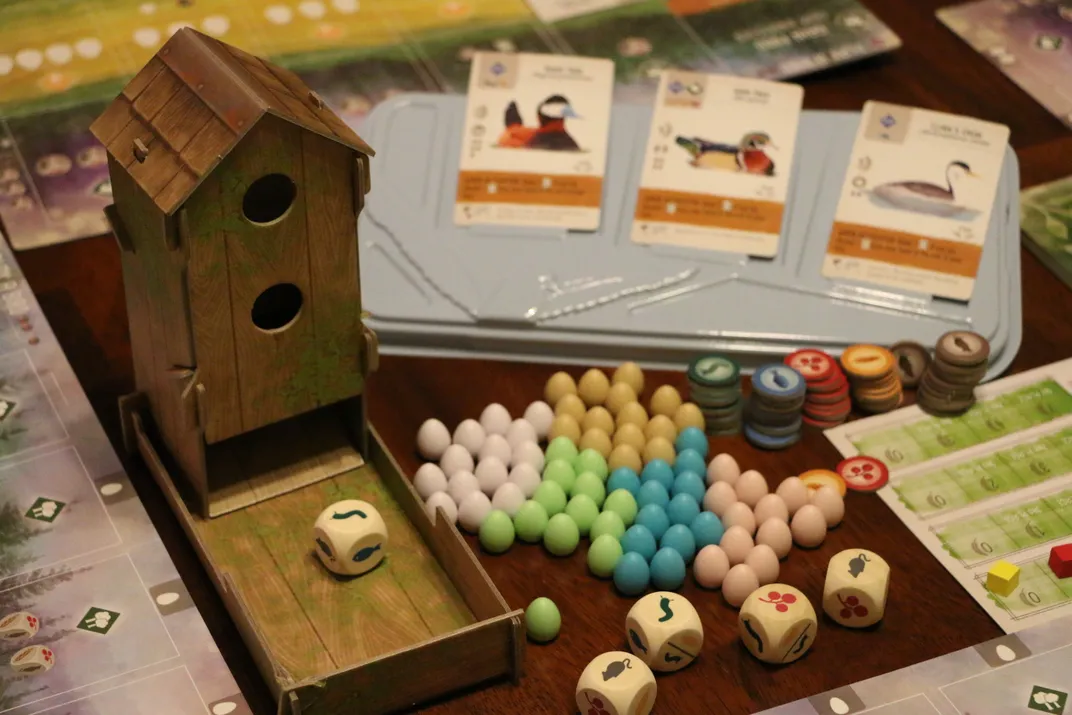This New Scientifically Accurate Board Game Is for the Birders
“Wingspan” features 170 unique species cards filled with real-world information, life-like illustrations
/https://tf-cmsv2-smithsonianmag-media.s3.amazonaws.com/filer/38/d5/38d51936-fd15-4e3a-9cb4-0556aac9412a/img_0272.jpg)
“Wingspan,” an eclectic new board game that transforms players into avian enthusiasts working to attract visitors to competing wildlife preserves, boasts a level of scientific rigor typically unseen in the gaming world.
As Siobhan Roberts reports for The New York Times, creator Elizabeth Hargrave—a self-proclaimed “spreadsheet geek” and avid birder—crafted “Wingspan” with mathematical precision: Drawing on data from the Cornell Lab of Ornithology’s eBird citizen-science project and All About Birds portal, as well as Audubon’s online guide to North American birds, Hargrave made a massive spreadsheet detailing information such as habitat, wingspan, red-list status and diet. At one point, the document reached a staggering size of 596 rows by nearly 100 columns.
To turn this treasure trove of factoids into a playable gaming experience, Hargrave collaborated with Stonemaier Games. Jamey Stegmaier, co-founder and president of the game publishing company, tells Audubon magazine’s Shaymus McLaughlin that he was instantly intrigued by Hargrave’s description of “Wingspan,” explaining, “There’s something about birds that instantly captures a human desire to collect, sort, and admire.”
Building on the standard of scientific integrity set by Hargrave’s research, Stegmaier recruited artists Natalia Rojas and Ana Maria Martinez Jaramillo to create life-like illustrations of the avian creatures at the heart of the game. Each gaming set features 170 unique bird cards replete with vital statistics, game-specific notes such as point values and special powers, and eye-catching colored pencil renderings of the species in question.
Given the fact that the United States and Canada are home to around 760 avian species, Hargrave had to be selective when choosing birds to include in the game. As she notes in an interview with Journal of Geek Studies, some species—for example, the roseate spoonbill, a pink-and-white bird native to Florida, Texas and Louisiana—made the cut due to her personal affinity for them. Overall, Hargrave says, she worked to incorporate a “diverse set” of North American birds while still featuring many commonly known species. (The Times’ Roberts adds that expansion packs detailing birds found on every continent are currently in the works.)

In board game parlance, “Wingspan” is what’s known as an engine-building game. As Audubon’s McLaughlin writes, the roughly hour-long competition finds players attempting to create an “increasingly effective system for generating points.” The winner, as you might have guessed, is the individual with the most points at the end of the game.
To play “Wingspan,” up to five players step into the shoes of ornithologists, bird watchers and collectors. Balancing bird cards, food tokens and multi-colored miniature egg pieces, competitors build avian networks by acquiring and deploying resources related to a specific species card. Take the roseate spoonbill, for instance: As Roberts observes, the species carries a value of six points. Placed in its native wetland habitat (rather than grassland or forest), the spoonbill can lay two point-generating eggs. Settling down comes at a cost, however, with players forced to cover a food requirement of one invertebrate, one seed and one fish. A special power conferred by the card is the chance to keep one of two extra bonus cards drawn from the deck.
Math and science underlie the very foundation of “Wingspan.” According to McLaughlin, the game’s strategy and scoring derive from real-world information: Brown-headed cowbirds, for example, earn players points by adding eggs to other birds’ nests—a behavior commonly exhibited by the species in the wild. Northern harriers and barred owls, on the other hand, boost players’ scores by preying on smaller birds.
In addition to providing players with a subtle science lesson, the game is powered by numbers. Players must balance the cost of obtaining food with points afforded by a bird’s special powers, or perhaps gauge the probability of landing on specific food items when rolling the dice. “There’s a large amount of math under the hood,” “Wingspan” tester Franklin Kenter tells Roberts. “But you don’t need to know the math to play the game.”
You might think an avian enthusiast board game would hold limited appeal, but as Roberts reports, “Wingspan” is currently on its third print run, with a total of 30,000 English games and 14,000 foreign-language editions in the works.
“I hope that it’s a game that you can play primarily as a game, without feeling like you’re supposed to be learning anything,” Hargrave concludes to Journal of Geek Studies. “... A lot of educational games feel very preachy to me, and that’s not my intention. But I do hope that as players interact with the birds in the game, some of the real-world information that’s there is interesting to them.”
/https://tf-cmsv2-smithsonianmag-media.s3.amazonaws.com/accounts/headshot/mellon.png)
/https://tf-cmsv2-smithsonianmag-media.s3.amazonaws.com/accounts/headshot/mellon.png)